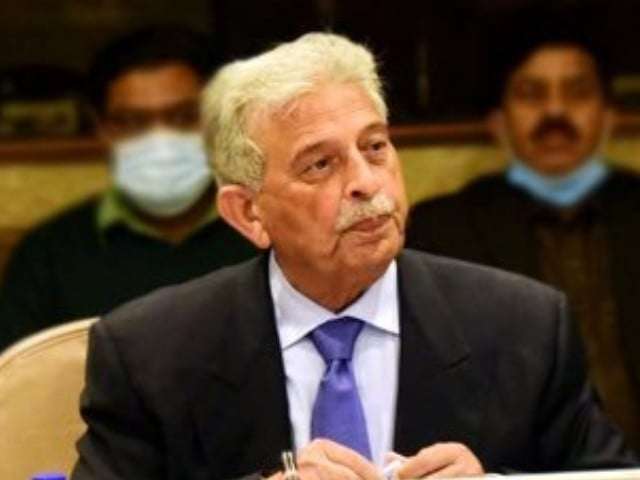Targeting $100 Billion in Exports: A Vision for Economic Revival
Pakistan’s Minister for Industries and Production, Rana Tanveer Hussain, has set an ambitious target of reaching $100 billion in exports within the next five years. Speaking at the Lahore Chamber of Commerce and Industry (LCCI) on Saturday, he outlined a comprehensive plan for achieving this goal, emphasizing the importance of research and development (R&D), industrial reforms, Special Economic Zones (SEZs), and value addition to drive export growth.
The minister’s remarks come at a crucial juncture, as the country faces economic challenges but is also witnessing signs of recovery through decisive actions taken by the government. Hussain stressed that these measures, particularly the reforms introduced by Prime Minister Shehbaz Sharif, are crucial for Pakistan’s economic revival and long-term prosperity.
Economic Revival Through Collaboration with the Business Community
Government’s Commitment to Economic Growth
Minister Hussain highlighted the government’s unwavering commitment to stabilizing and revitalizing the national economy, emphasizing the vital role of the business community in this process. He expressed optimism about the future of Pakistan’s economy, citing the government’s recent efforts to introduce structural reforms aimed at bolstering the industrial sector and stimulating exports.
“The Prime Minister’s calls for a ‘Charter of Economy’ resonate deeply, as it emphasizes a shared commitment to long-term economic stability,” Hussain said. “This collaboration will ensure that our economy remains on a sustainable growth path, despite the challenges we currently face.”
Historical Context: The Role of PML-N’s Economic Policies
Hussain also took time to reflect on the historical significance of the economic reforms implemented during various terms of the Pakistan Muslim League-Nawaz (PML-N) government. He particularly praised the economic policy changes introduced by former Prime Minister Nawaz Sharif in the 1990s, noting that these reforms had a lasting impact on Pakistan’s economic trajectory.
He pointed out that the policies implemented during this period were later adopted by former Indian Prime Minister Manmohan Singh, which led to significant economic growth in India. The benefits of these policies continue to be felt today, underscoring their importance in shaping the economic landscape of the subcontinent.
Pragmatic Reforms and Investment Opportunities
Reforming the Energy Sector
One of the key areas of focus for the government has been reducing production costs, particularly through energy sector reforms. According to Hussain, a comprehensive review of agreements with Independent Power Producers (IPPs) has resulted in reduced electricity costs. The government is optimistic that electricity prices will see further reductions by April, easing the burden on industrial producers.
“In the coming months, we expect further reductions in electricity costs, which will directly benefit industries and exporters,” said Hussain. “This is part of our broader effort to lower production expenses and make Pakistani products more competitive in the global market.”
Interest Rate Cuts to Encourage Investment
Additionally, the government’s efforts to lower interest rates have been a critical step in fostering a more conducive environment for business growth. Hussain revealed that interest rates have been reduced from 22% to 12% over the past ten months, making borrowing more affordable for businesses. However, the minister noted that the State Bank of Pakistan (SBP) operates independently, limiting direct government influence on monetary policies.
Investment in Research and Development (R&D)
To further boost economic growth, the minister called for increased investment in R&D, especially within the industrial and agricultural sectors. “We need to focus on innovation and technological advancement to stay ahead in global markets,” Hussain stated. “R&D will be a key factor in ensuring that our industries remain competitive, especially as we explore new export markets.”
He also encouraged Pakistani exporters to shift their focus toward value addition and diversify their markets by tapping into emerging regions such as Central Asia and Africa. The government, he said, is committed to supporting these efforts by providing incentives and creating a favorable business climate.
Developing Special Economic Zones (SEZs)
In an effort to further promote industrial growth, Hussain announced plans to reduce land prices in Special Economic Zones (SEZs) and Export Processing Zones (EPZs). These zones are designed to attract both local and foreign investment by offering favorable terms such as tax exemptions and infrastructure support.
“We plan to develop SEZs on land currently owned by Pakistan Steel Mills, which will provide ample space for industrial growth and attract new businesses,” said Hussain.
Tackling Bureaucratic and Fiscal Challenges
Despite these reforms, the minister also acknowledged the challenges posed by the Federal Board of Revenue’s (FBR) policies, particularly in terms of taxation. According to Hussain, excessive taxation has acted as a barrier to economic growth. He called on the business community to work together to advocate for policies that promote growth and reduce the burden on the private sector.
Challenges to Achieving Export Growth
Energy Costs and Industrial Land Prices
LCCI President Mian Abuzar Shad, who was also present at the event, raised several concerns regarding rising energy costs, MDI (Maximum Demand Indicator) charges on inactive industrial units, and the high policy interest rates. While the interest rate had been reduced to 13%, Shad emphasized that it still remained uncompetitive when compared to regional countries.
“To attract more investment and encourage exporters, we need to reduce the interest rate further to single digits,” Shad stated.
Furthermore, Shad highlighted the issue of escalating industrial land prices, which have reached Rs50 million per acre. This high cost of land poses a significant obstacle to investment, particularly in the industrial sector. He called for immediate measures to address this issue, as it has made Pakistan’s export competitiveness weaker on the global stage.
Ensuring Raw Material Availability
Another challenge raised by Shad was the availability of raw materials, such as metals, steel, and textiles. He stressed the importance of ensuring that these materials remain available to industries at competitive prices, as they are critical to the production of goods for export. Shad also advocated for the implementation of cascading tariffs to avoid industrial distortions that can harm local industries.
The Path Forward: Expanding Pakistan’s Export Potential
Minister Hussain concluded his speech by reiterating the government’s commitment to achieving the export target of $100 billion by 2029. “We must work together to overcome the challenges, focus on value addition, invest in R&D, and explore new markets,” he said. “If we stay committed to these goals, we can revitalize our economy and achieve sustainable growth.”
FAQs: Pakistan’s Export Growth Strategy
1. What is Pakistan’s export target for the next five years?
The target set by the federal government is to achieve $100 billion in exports by 2029. This ambitious goal aims to stimulate the economy and boost industrial production.
2. How does the government plan to reduce production costs?
The government plans to reduce electricity costs, lower interest rates, and invest in research and development (R&D) to ease production expenses and improve the competitiveness of Pakistani products.
3. What reforms are being introduced in Special Economic Zones (SEZs)?
The government is working to reduce land prices in SEZs and Export Processing Zones (EPZs) to attract investment. Additionally, there are plans to develop SEZs on land owned by Pakistan Steel Mills.
4. Why are energy costs a concern for businesses?
Energy costs are a significant concern as they increase production expenses. Rising energy prices have been a burden on industries, impacting their ability to remain competitive.
5. What is the role of the Federal Board of Revenue (FBR) in Pakistan’s economic challenges?
The FBR’s excessive taxation policies have been identified as barriers to growth. Minister Rana Tanveer Hussain has urged the business community to address these challenges and advocate for more business-friendly fiscal policies.



